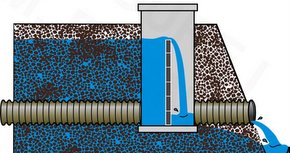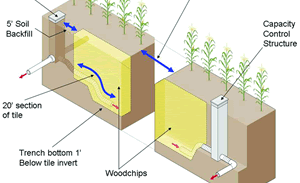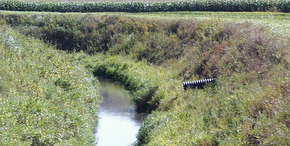What is conservation drainage?
Subsurface tile drainage is an essential agricultural water management practice on many highly productive soils in the Midwest. However, nitrate carried in drainage water can lead to local water quality problems and contribute to hypoxia in the Gulf of Mexico, so strategies are needed to reduce the nitrate loads while maintaining adequate drainage for crop production. The term "conservation drainage" has been coined to describe practices that can reduce nitrate loads on tile-drained soils, including modifying drainage system design and operation, woodchip bioreactors, and modifications to the drainage ditch system. This web site provides information that has been developed by university extension specialists and researchers to inform farmers, agency staff, decision makers, and others about these practices.
Practices that reduce nitrate from drainage systems
Drainage water management

Drainage water management is the practice of using a water control structure to raise the drainage outlet to various depths. This allows farmers to have more control over drainage.
MoreWoodchip bioreactors
 Bioreactors consist of a large trench filled with woodchips or other carbon sources, that allow microbes to treat drainage water through denitrification.More
Bioreactors consist of a large trench filled with woodchips or other carbon sources, that allow microbes to treat drainage water through denitrification.More
Drainage system & ditch design

The drainage system can be designed to reduce nitrate losses by using shallower drains, wider spacing, and two stages within the ditch to increase nutrient trapping and processing.
MoreUSDA Natural Resources Conservation Service resources
- Ag Water Management Team
- Conservation practice standards
- Drainage Water Management
- Denitrifying Bioreactor (some states only)
- Conservation Security Program Enhancement - DWM
State initiatives and opportunities
- Minnesota Department of Agriculture - Conservation Drainage
Land-grant university resources
Illinois: Richard Cooke, Agricultural & Biological Engineering, University of Illinois; Web Site: Illinois Drainage Guide
Indiana: Jane Frankenberger, Agricultural & Biological Engineering; Eileen Kladivko, Agronomy; Purdue University; Web Site:Purdue Ag Drainage
Iowa: Matt Helmers, Iowa State University; Web Site:Ag Water Management Research
Michigan: Tim Harrigan, Michigan State University
Minnesota: Gary Sands, University of Minnesota; Web Site:The Drainage Outlet
Missouri: Kelly Nelson, University of Missouri;
North Dakota: Xinhua Jia, North Dakota State University
Ohio: Larry Brown, The Ohio State University
South Dakota: Chris Hay, South Dakota State University